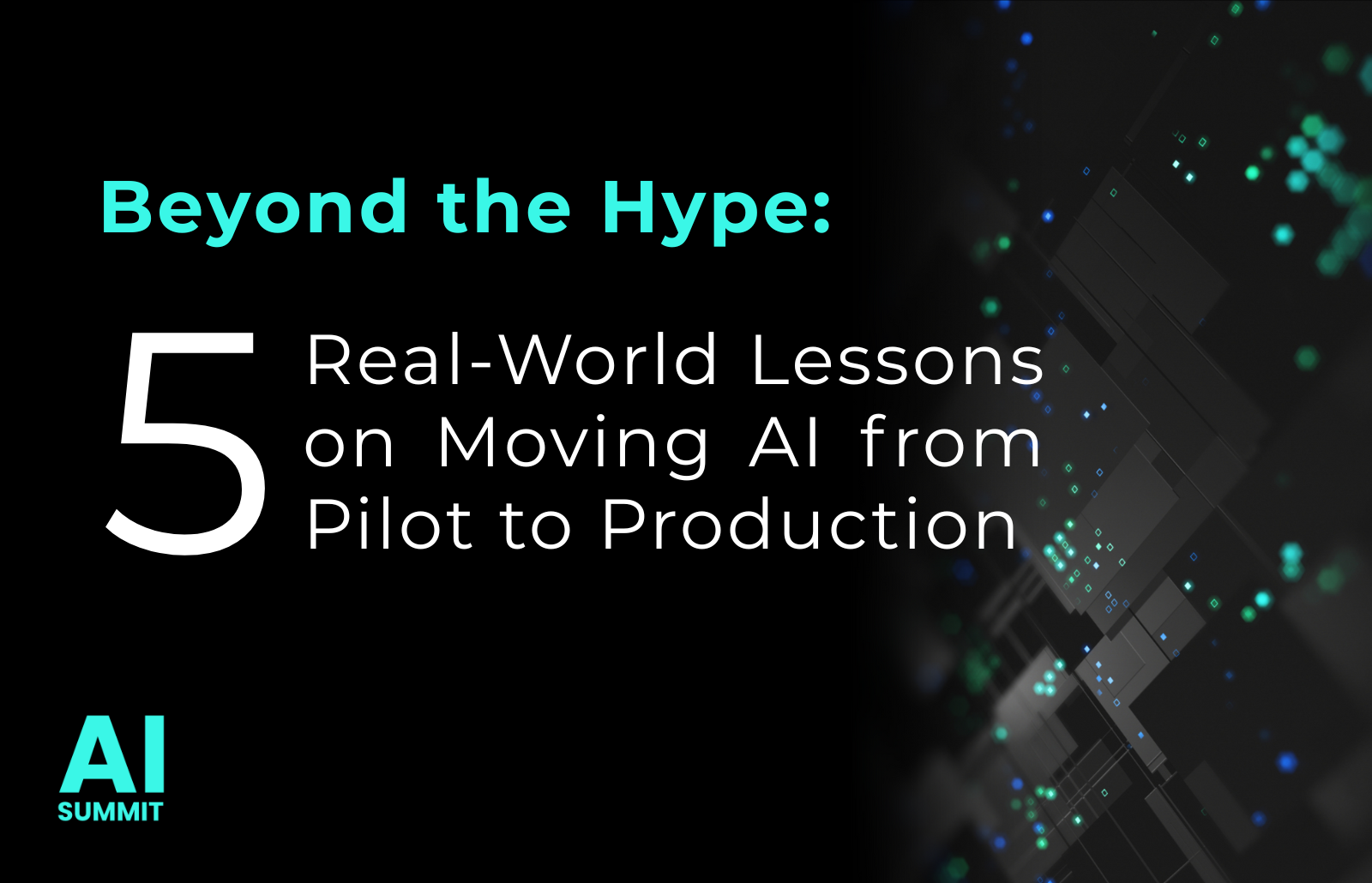The modern business landscape is saturated with the promise of Artificial Intelligence. Companies are investing billions annually, driven by staggering projections, such as a PWC study forecasting a potential $15.7 trillion uplift to the global GDP by 2030. Yet, a paradox lies at the heart of this gold rush. According to a widely-cited MIT study, a sobering 95% of AI pilots fail to ever make it into production. As Sudha Regmi, Director of Data & AI at Nourish Care, highlights, this disconnect between hype and reality isn’t a technology problem—it’s a strategy problem.
This guide moves beyond the hype to distill five actionable lessons for navigating the treacherous path from a promising pilot to a value-generating production system. Drawing on the hard-won experiences of leaders who have successfully bridged this gap, we will explore the strategic, operational, and cultural shifts required to turn AI’s potential into a tangible business reality.
Lesson 1: It’s a Business Transformation, Not a Tech Project
The most critical mistake an organization can make is to frame its AI initiative as a pure technology project. This fundamental misjudgment is the leading cause of the investment-value mismatch that plagues the industry. True AI adoption is not about bolting on a new tool; it’s about fundamentally re-architecting how the business operates, creates value, and serves its customers.
Sudha Regmi states this plainly, noting that most failures stem from companies treating AI as a “technology transformation rather than a business transformation.” This sentiment is powerfully echoed by other technology leaders at the Zartis AI Summit, who argue that being “AI native” is not about an architecture diagram but about a “holistic business transformation.” It’s a shift in mindset that must permeate every level of the organization, from the C-suite to the front lines.
This high-level strategy translates into tangible, ground-level practices:
- Tie it to the bottom line. Panelist Darren Hayes, a Senior Director at McKesson, emphasizes the need for discipline by tying every initiative back to core business metrics like “annual operating profit.” If the line between the AI project and a core financial outcome is unclear, the project’s justification is weak.
- Focus on user value. Charles Kent, a Product Design Lead at Evotix, approaches this from a user-centric perspective, leveraging the “jobs to be done” framework. This ensures that the AI solution is not just technically impressive but is laser-focused on solving a real, quantifiable problem for the end user.
Therefore, the first step in any AI initiative must be to secure C-suite agreement that it is a business transformation program with P&L impact, not an R&D experiment.
Lesson 2: Ruthlessly Validate the Business Problem First
The path to AI failure is often paved with good intentions and technically brilliant solutions to problems that don’t actually exist. The primary antidote to this common pitfall is a ruthless and systematic process of use case validation. This disciplined approach ensures that resources are directed toward initiatives with a clear and verified return on investment, preventing the “investment-value mismatch” that dooms so many projects.
As a prime example, Sudha Regmi’s team at Nourish Care implemented a systematic validation process to cut through the noise. They began by building a backlog of 40 potential use cases sourced from across the business. Instead of letting personal preference or technological novelty drive the roadmap, they conducted a formal survey among executives, forcing a prioritization based on a clear framework of value, effort, and risk. This structured process filtered the 40 possibilities down to a handful of high-priority initiatives that were directly aligned with the company’s strategic goals.
This disciplined approach stands in stark contrast to the cautionary tale offered by panelist Jane Cummings, CTO of Outmin. She warns against the “seduction” of a cool demo that gets leaders excited but hasn’t been critically evaluated. It’s easy to fall in love with a prototype that looks like magic, but without rigorously asking whether it solves a real problem, has a viable ROI, and is technically scalable, you are investing in a dead end.
This rigorous filtering ensures that investment is channeled not just into interesting problems, but into valuable ones, directly shielding the organization from building technically brilliant but commercially irrelevant solutions.
Lesson 3: Mind the “Pilot to Production Chasm”
There is a treacherous gap between a successful pilot and a production-ready system—a chasm where the vast majority of technically promising AI projects ultimately fail. A compelling demo running on a clean dataset is fundamentally different from a scalable, reliable, and secure system operating in the chaos of the real world. Sudha Regmi observes that while the barrier to entry for an AI pilot is now very low, the complexity and effort required for productionization are massively underestimated.
Successfully bridging this gap requires confronting a unique set of operational challenges that don’t exist in traditional software development. Insights from the expert panel reveal several key hurdles:
- Data Integrity: Darren Hayes asserts that “data health and data hygiene” is the single biggest and most fundamental challenge. A model trained on curated data will inevitably fail when exposed to the messy, inconsistent, and incomplete data of a live production environment. Without a solid data foundation, no AI initiative can succeed.
- Scalability and Robustness: A prototype that works for a single use case may be impossible to scale. Jane Cummings shared an example of an agent-based prototype that performed a task beautifully in a demo. However, the team realized the complexity of scaling it across thousands of different client scenarios would make it too brittle and costly to maintain robustly, forcing them to shelve the project.
- Testing and Monitoring: AI systems are often non-deterministic, making traditional testing methods inadequate. As Darren Hayes points out, models that perform well in testing can still fail on production data. This necessitates new strategies like continuous monitoring for “model data drift” to detect when a model’s performance is degrading over time and requires retraining.
Therefore, AI roadmaps must budget for the “chasm” as a distinct, resource-intensive project phase, not as the final 10% of a pilot.
Lesson 4: Make Change Management a Company-Wide Mission
Technology alone delivers no value. Its potential is only unlocked when it is adopted and integrated by people into their daily workflows. A brilliant AI tool that nobody uses is a costly failure, which is why poor change management is one of the most significant, yet frequently overlooked, reasons for the 95% pilot failure rate.
Some experts advocate for a comprehensive, three-tiered model to drive buy-in and ensure that transformation is a company-wide mission, not just an IT project:
- Leadership: The journey must begin with securing unwavering, top-down commitment from the executive team.
- The Lab: The next step is to identify and empower “the lab”—the curious, brave, and experimental first adopters who can champion the change, test new tools, and demonstrate their value to the rest of the organization.
- The Crowd: With champions in place, the focus shifts to bringing “the crowd”—all other employees—along on the journey through structured training, clear communication, and ongoing support.
This holistic view suggests that transformation is needed across “all functions at all levels” and that organizations cannot simply “throw tools at people” and expect meaningful adoption.
However, there is more depth to this topic and we should warn that leadership buy-in can be a “double-edged sword.” While executive excitement is essential, it must be paired with active education to manage expectations around realistic costs, timelines, and capabilities. Without this grounding, initial enthusiasm can quickly turn into disillusionment when the first hurdles appear.
Consequently, technology leaders must treat change management not as a communications task, but as a core strategic function with dedicated resources, executive champions, and clear metrics for adoption.
Lesson 5: Aim for a Head Start, Not an Unbreachable Moat
In the fast-moving world of AI, the traditional concept of building a permanent, unbreachable competitive “moat” is becoming less relevant. The pace of technological change means that today’s advantage can become tomorrow’s table stakes. A more pragmatic and effective strategy is to focus on achieving and maintaining momentum.
We urge companies to have the “humility of realizing maybe we just have a head start.” This mindset shifts the focus from building a perfect, static defense to continuously iterating and leveraging unique assets to stay ahead. This head start should be multifaceted, built on unique assets that a startup couldn’t easily replicate. Central to this was their proprietary data, comprising two decades of human-curated regulatory documents and thousands of historical Q&A sessions revealing what customers struggled with most. This was amplified by deep domain expertise from their in-house legal team—the essential “human in the loop”—and the immense customer trust they had built over years, an intangible but powerful advantage against newcomers armed only with a slick algorithm.
This philosophy of pragmatic momentum is reinforced by Darren Hayes’s advice to avoid “analysis paralysis.” He advocates a bias for action, urging teams to “just ship it… and you can always iterate.” This approach prioritizes learning and real-world feedback over waiting for an unattainable perfect solution.
The strategic mandate, therefore, is to prioritize momentum over perfection, continuously leveraging unique assets to maintain a lead rather than waiting for an unbreachable, and likely unattainable, moat.
Conclusion
Successfully moving AI from pilot to production is one of the most formidable challenges facing modern organizations, but it is not an insurmountable one. The five lessons from leaders on the front lines reveal a clear and consistent thesis: success is less about chasing technological magic and more about disciplined business strategy. It requires ruthlessly validating the problem you are trying to solve, soberly planning for the chasm between a demo and a deployed product, and fostering a company-wide commitment to change. AI’s potential to transform industries is enormous, but realizing that potential requires navigating a difficult road—one paved not with hype, but with strategic rigor, operational excellence, and a deep understanding of human and business needs.

